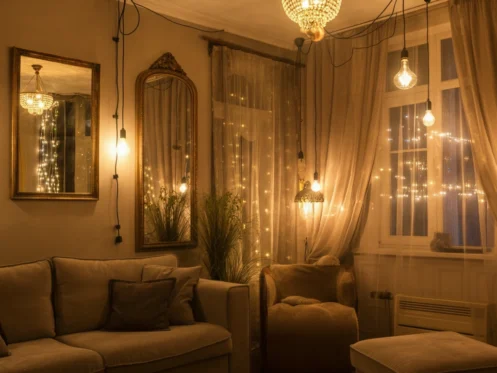Indoor lighting is a powerful tool in shaping the ambiance of any space. When done correctly, it can transform a room from ordinary to extraordinary, highlighting key features and creating a welcoming environment. Whether you’re looking to improve functionality, enhance your home’s aesthetics, or save energy, the right lighting can make a significant difference. In this blog, we’ll share 6 practical tips to elevate your indoor lighting and help you achieve the perfect atmosphere in every room.
1. Harness the Power of Natural Light
Natural light is a free and abundant resource that can dramatically improve the mood and atmosphere of any room. It can create a vibrant, welcoming space and promote a sense of well-being.
Use these strategies to maximize natural light:
- Keep windows clean and unobstructed: This lets natural light flow freely into your home.
- Opt for light curtains or blinds: Sheer curtains or blinds allow natural light to filter through while maintaining privacy.
- Strategically use mirrors: Placing mirrors across from windows will reflect sunlight throughout the room, brightening dark corners and making the space feel larger.
Natural light can change throughout the day, so pay attention to when it’s brightest and how it influences the mood of a room. It’s also important to filter direct sunlight during peak hours, using blinds or shades to avoid glare.
2. Layer Your Lighting
One of the best ways to enhance your indoor lighting is by layering light sources at different levels. This technique ensures that your space is illuminated according to function and ambiance. Layering typically includes three types of lighting: ambient, task, and accent.
- Ambient lighting: This provides the overall illumination in a room. Common options include overhead lights, chandeliers, and recessed lights. It should be soft and diffused to avoid harsh shadows.
- Task lighting: This type of lighting is focused on specific tasks, such as reading, cooking, or working. Desk lamps, pendant lights, and under-cabinet lighting are excellent examples.
- Accent lighting: Accent lighting highlights particular features or decorative elements in a room, such as artwork, sculptures, or architectural details. It’s usually brighter than ambient lighting and should create a focal point.
By combining these different layers, you can create a dynamic and adaptable lighting system that enhances the functionality and aesthetics of your space.
3. Choose the Right Light Fixtures

Selecting the right light fixtures is essential for achieving both functionality and style. The fixture’s design should complement your room’s décor, while its functionality should cater to your lighting needs.
- Fixture style: Opt for fixtures that align with the overall design theme of your space. For instance, chandeliers or sconces add a classic touch, while track lighting or pendant lights suit modern interiors.
- Color temperature: Choose bulbs that provide the right color temperature for each room. Warm white light (2700-3000K) creates a cozy, relaxed atmosphere, ideal for bedrooms or living rooms. In contrast, cool white light (4000-5000K) is better for task-oriented spaces like kitchens or home offices.
- Fixture size and scale: Choose fixtures that are proportionate to the size of the room. An oversized chandelier in a small room can feel overpowering, while a small pendant light in a large room may seem out of place.
Opt for energy-efficient bulbs, such as LEDs, which are not long-lasting and reduce electricity consumption.
4. Consult a Professional for Expert Advice
While the above tips can make a noticeable difference, consulting a professional lighting designer can help you fine-tune your lighting setup. They have the expertise to assess your space and recommend tailored solutions that meet both aesthetic and practical needs.
A lighting expert will guide you in choosing the right fixtures, light placement, and color temperatures. They can also help you stay on top of the latest energy-efficient trends and offer advice on integrating lighting with smart home technology. Although hiring a professional may involve an initial cost, their advice can save you money by preventing costly mistakes and ensuring your lighting is as effective as possible.
5. Upgrade to Energy-Efficient Lighting
Old, inefficient light fixtures can drain energy and lead to high utility bills. Upgrading to energy-efficient lighting is a simple yet impactful way to reduce costs and improve indoor lighting quality.
Consider these steps:
- Replace incandescent bulbs with LED bulbs: LEDs are energy-efficient, long-lasting, and available in various color temperatures to suit different needs. They consume less energy, helping you save on your electricity bill.
- Update outdated fixtures: If your fixtures are old or worn out, consider replacing them with modern, energy-efficient alternatives that provide better lighting and fit your room’s style.
Investing in new, high-quality light fixtures and bulbs will not only improve the look of your space but also reduce your carbon footprint.
6. Incorporate Smart Lighting for Convenience and Control
Smart lighting offers ultimate convenience and control over your home’s lighting system. With the help of smart bulbs or smart lighting systems, you can adjust the brightness, color temperature, and even the hue of your lights remotely, using a smartphone app or voice commands.
Key benefits of smart lighting:
- Remote control: Adjust your lights from anywhere, whether you’re on the couch or away on vacation.
- Customizable lighting scenes: Set specific lighting moods for various activities, such as reading, working, or entertaining.
- Energy savings: Smart lighting allows you to automate your lights, ensuring they’re turned off when not in use, which can help reduce energy consumption.
- Increased security: Some smart lighting systems can be programmed to turn on and off automatically, creating the appearance that someone is home, even when you’re not.
Smart lighting is an investment that enhances convenience, energy efficiency, and security—all while adding a modern touch to your home’s lighting.
Conclusion
Indoor lighting plays a crucial role in setting the tone and atmosphere of your home. You can transform your space and make it more functional by layering light, selecting the right fixtures, and using energy-efficient options (such as LED bulbs and smart lighting). The right lighting makes your home feel more spacious, inviting, and full of life, turning it into a space that’s truly your own.
Need help with your lighting needs? Precision Plumbing, Heating, Cooling & Electric offers expert lighting design and installation. Contact us today to schedule a consultation and brighten up your home!



